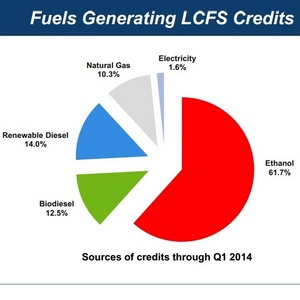Public comments on low carbon fuel availability due Oct. 16

California Air Resources Board
October 15, 2014
BY Erin Krueger
The recently established Low Carbon Fuels Coalition is encouraging low carbon fuel producers and other industry stakeholders to weigh in on the availability of low carbon fuels by submitting comments to the California Air Resources Board.
On Sept. 25, CARB held a public workshop on the state’s Low Carbon Fuel Standard to discuss the availability of low carbon fuels. According to Graham Noyes, acting director of the LCFC and attorney with Keyes, Fox & Wiedman LLP, CARB’s determinations regarding low carbon fuel availability will have a significant impact on the setting of the carbon intensity curve.
Information presented during that meeting indicates ethanol fuels generated 61.7 percent of the LCFS credits through the first quarter of this year. Over the same time frame, biodiesel generated 12.5 percent of the credits, renewable diesel generated 14 percent, natural gas generated 10.3 percent and electricity generated 1.6 percent.
CARB staff evaluates expected fuel availability for compliance with the LCFS. As part of that evaluation, the staff considers what fuels are available national and internationally, as well as whether or not those fuels could and would be sold in California. According to information presented at the workshop, national fuel availability sets the upper bound volumes of fuels that could be used to comply with the LCFS. Staff investigates fuel capacity, as well as past and current fuel production. Production is also evaluated by feedstock and staff looks for growth patterns for each feedstock. Bounds are set for feedstocks expected to have limited growth potential.
Advertisement
In 2020, CARB expects there to be approximately 14.8 billion gallons of ethanol available from corn and sorghum feedstocks, along with 850 million gallons to 1.75 billion gallons from sugarcane. An additional 150 million to 500 million gallons of molasses-based ethanol is expected to be available. Approximately 100 million gallons to 250 million gallons of U.S. cellulosic ethanol is expected to available, along with 150 million to 300 million gallons of Brazilian cellulosic ethanol.
CARB also forecasts that between 100 million gallons and 160 million gallons of renewable gasoline is expected to be available by 2020. The supply of renewable diesel is expected to be higher, with between 900 million gallons and 1.5 billion gallons expected to be available by 2020. An additional 2 billion gallons of biodiesel is expected to be available in 2020. According to CARB, total transportation natural gas consumption in 2020 is expected to reach between 600 million and 1.2 billion diesel gallon equivalent (DGE), including 250 million to 500 million DGE from renewable natural gas. Additional low carbon fuels availability is expected from electricity and hydrogen sources. Other potential low carbon fuels include algae diesel, gas-to-liquids diesel, biomass-to-liquid diesel, dimethyl ether, and biobutanol.
CARB has invited public comments on its projected volumes for low carbon fuel availability. The LCFC has published a sample letter on its website complete with submission directions. The letter includes a section where each commenter can provide relevant information on how much fuel they expect a particular company or sector to provide. The letter also outlines the importance of California’s LCFS program to low carbon fuel producers and suppliers.
Advertisement
Noyes said the goal of submitting comments is to make sure CARB understands everything going on in the low carbon fuels industry, both in terms of existing capacity and what is currently under development. The board, he stressed, cannot gain all the information it needs just from looking at information available in the public domain.
The LCFC is a broad-based coalition that crosses over the many sectors active in the low carbon fuels industry. Membership currently includes ethanol producers, biodiesel producers, renewable gas producers, a company converting waste to crude oil, as well as retailers.
Comments are due Oct. 16 and can be emailed to ksideco[at]arb.ca.gov. A copy of LCFC’s sample letter is available on the coalition’s website. Additional information on CARB’s low carbon fuel projections can be found in a staff presentation published in September.
Related Stories
U.S. fuel ethanol capacity fell slightly in April, while biodiesel and renewable diesel capacity held steady, according to data released by the U.S. EIA on June 30. Feedstock consumption was down when compared to the previous month.
XCF Global Inc. on July 8 provided a production update on its flagship New Rise Reno facility, underscoring that the plant has successfully produced SAF, renewable diesel, and renewable naphtha during its initial ramp-up.
The U.S. EPA on July 8 hosted virtual public hearing to gather input on the agency’s recently released proposed rule to set 2026 and 2027 RFS RVOs. Members of the biofuel industry were among those to offer testimony during the event.
The U.S. exported 31,160.5 metric tons of biodiesel and biodiesel blends of B30 and greater in May, according to data released by the USDA Foreign Agricultural Service on July 3. Biodiesel imports were 2,226.2 metric tons for the month.
The USDA’s Risk Management Agency is implementing multiple changes to the Camelina pilot insurance program for the 2026 and succeeding crop years. The changes will expand coverage options and provide greater flexibility for producers.
Upcoming Events










